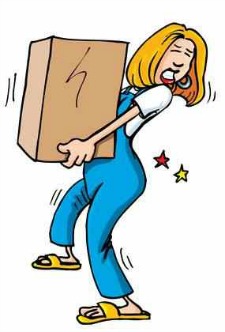Sensory Motor Amnesia
A Powerful, Hidden Cause of Lower Back Pain

Sensory Motor Amnesia is a term coined by Thomas Hanna in his groundbreaking book, Somatics: Reawakening the Mind’s Control of Movement, Flexibility, and Health.
The term describes a phenomenon in which individuals lose both sensory awareness and muscular control of certain parts of their bodies. They no longer have the ability to sense which muscles are being held in a state of chronic tightness and which are relaxed.
Muscles held in a perpetual state of contraction will invariably become painful due to ischemia (low blood flow, like the white knuckles of a clenched fist).
Sensory Motor Amnesia is a conditioned response in the brain resulting from injury, long-term stress, or postural distortion.
Sensory Motor Amnesia Resulting from Injury
Following injury, the brain sends signals to the body to recoil from movement of the injured area. This is a natural and positive response, aimed at protecting the body from further injury.
However, if conscious, active movement is not initiated after the injury has healed, the original reflexive contraction may remain.
Example:
A guy named Mike slips on an icy sidewalk and lands in a sitting position on his tailbone.
This jars his sacroiliac joints and strains his sacroiliac ligament (which covers the surface of the sacrum). The muscles in his buttocks and lower back contract to reduce movement in the sacroiliac joints, movement which would be painful.
This is positive, protective response. However, after the strain has healed in the sacroiliac ligament, the muscles in his buttocks and lower back do not automatically relax. They have become accustomed to a state of habitual tension. Mike’s brain has lost conscious control of them.
This is sensory-motor amnesia. The original injury has passed but now there’s a new source of pain: chronic muscular contraction in the buttocks and lower back.
Sensory Motor Amnesia Resulting from Long-Term Stress
Another type of conditioned response is that caused by long-term stress. The powerful potential effects of stress on our muscles cannot be overstated.
The body experiences both a biochemical as well as a
neuromuscular response to sustained stress. The neuromuscular response
can be an intense, sustained contraction of our musculature.
Example:
Ruth works in an office in which her boss is not only disorganized and unpleasant, but he blames others for his mistakes.
Ideally, Ruth would prefer to work somewhere else, but she’s a single mother, has three kids at home, and the benefits and salary of this job are as good as she’s going to find, given her skills.
The stress of this situation results in shallow breathing and a strong contraction of Ruth’s abdominal muscles, though she’s not aware she’s doing it.
When Ruth leaves the office at the end of the day, she takes her stress with her because she knows she has to return tomorrow, and the next day, and perhaps every day for the rest of her life. Or so it seems.
The constant muscular contraction of her abdominals pulls her body into a gathered, round-shouldered shape, and this causes her back muscles to respond with their own contraction.
Thus, her abdominal muscles and her lower back muscles begin to engage
in a wrestling match. Ruth has fallen victim to sensory motor amnesia.
Sensory Motor Amnesia Resulting from Postural Distortion
Another problem which can lead to sensory motor amnesia is the unconscious muscular contraction that occurs as a result of postural distortion.
If an individual has a torsion in their pelvis, for example, often the result will be a functional leg-length difference. This leg-length difference will cause that individual to lean off the center-line of gravity when walking or standing.
But the body always seeks balance and will compensate by pulling itself upright. This action, however, can only be accomplished with a powerful act of muscular contraction in the back muscles.
Example:
Jim works out all the time – he runs and bikes and lift weights – but he never stretches.
Also, Jim spends a lot of time in his car, commuting back and forth to work. The result is that Jim’s primary hip flexors (his iliopsoas muscle) have become extremely tight and short.
The left hip flexor is especially tight and short because Jim drives with his left knee bent. This situation has led to a posterior rotation in his left pelvic bone, resulting in a functionally short left leg.
When Jim stands or walks, his body tends to lean off-center, toward the functionally short left leg.
But his body doesn’t allow him to remain in this leaning position. His body compensates with the powerful contraction of his right quadratus lumborum muscle in his lower back.
This muscle spends so much time in a contracted state that, when Jim lies down at the end of the day, the quadratus lumborum doesn’t relax.
It has become conditioned to be in a contracted state, and Jim has lost his ability to sense or control it. Again we see sensory motor amnesia at work.
What To Do
The state of habitual tension that develops as a result of sensory motor amnesia is not an injury to be fixed but a conditioned response to be changed.
That change can be accomplished by reawakening the brain, and by regaining sensory motor control. The gentle, easy-to-do movements of Hanna Somatic Education were designed for exactly this purpose.
By consciously contracting and relaxing a muscle with a targeted movement, it becomes possible to reawaken sensory motor control. The reconnection between the brain and the muscles is what finally eliminates sensory motor amnesia.
You can experience the most fundamental of these movements on the stretching videos page. It is called the Somatic Pelvic Tilt and it is the first video on the page.
Return to Top | Causes Index | Home Page
Anatomy Images Courtesy of BIODIGITAL

|
CURRENT COURSES POSTURAL BLUEPRINT FOR CORRECTING PELVIC TORSION: The Complete Guide To Restoring Pelvic Balance (2022) STRETCHING BLUEPRINT FOR PAIN RELIEF & BETTER FLEXIBILITY: The Complete Guide to Pain-Free Muscles Using Active Isolated Stretching (2020) HEALING THE HIDDEN ROOT OF PAIN: Self-Treatment for Iliopsoas Syndrome (2013) FREE MINI COURSE: Introduction to Active Isolated Stretching |

